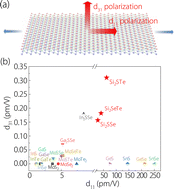Two-dimensional Janus Si dichalcogenides: a first-principles study†
Abstract
Strong structural asymmetry is actively explored in two-dimensional (2D) materials, because it can give rise to many interesting physical properties. Motivated by the recent synthesis of monolayer Si2Te2, we explored a family of 2D materials, named Janus Si dichalcogenides (JSD), which parallel the Janus transition metal dichalcogenides and exhibit even stronger inversion asymmetry. Using first-principles calculations, we show that their strong structural asymmetry leads to a pronounced intrinsic polar field, sizable spin splitting, and large piezoelectric response. The spin splitting involves an out-of-plane spin component, which is beyond the linear Rashba model. The piezoelectric tensor has a large value in both in-plane d11 coefficient and out-of-plane d31 coefficient, making monolayer JSDs distinct among existing 2D piezoelectric materials. In addition, we find interesting strain-induced phase transitions in these materials. Particularly, there are multiple valleys that compete for the conduction band minimum, which will lead to notable changes in the optical and transport properties under strain. Our work reveals a new family of Si based 2D materials, which could find promising applications in spintronic and piezoelectric devices.



 Please wait while we load your content...
Please wait while we load your content...